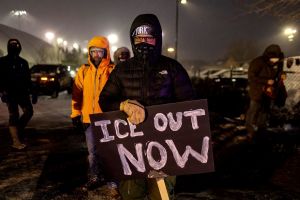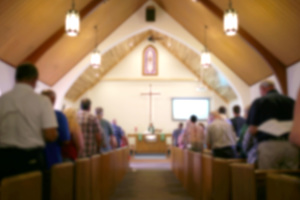States, cities lock down, enact new restrictions for 'third wave' of COVID-19

Several states are going back on lockdown — one even threatening to arrest violators — after reporting increased numbers of people testing positive for COVID-19.
However, those with the disease account for only a small share of hospital beds in the United States, and the pace of deaths is quickening just slightly in what some term coronavirus’ "third wave.”
Nationally, over the last week, the U.S. Centers for Disease Control and Prevention reported the daily number of people newly confirmed with the virus has ranged between 140,000 and 195,000. That figure is up significantly. But, testing also has doubled over the last few weeks. The seven-day moving average of deaths has increased slightly.
Oregon on Wednesday begins limiting indoor gatherings to six people from only two households. “Faith-based” organizations can meet with 25 inside or 50 outdoors, while grocery stores, pharmacies, malls and retail stores may admit 75% of shopper capacity.
Gov. Kate Brown's state police and local law enforcement will charge violators with misdemeanors that are reportedly punishable by arrest or citation.
Nevertheless, Oregon stated on Monday that 347 people are hospitalized with COVID-19 (6% of state bed capacity) statewide. According to The Oregonian, the state saw "a dramatic jump of almost 40 people" admitted to hospitals over the weekend.
The CDC data shows the state and rest of the West Coast don’t have as high of a surge in case rate, defined as the number of people per 100,000 who test positive, like other states, such as those in the Midwest. California and Washington state also have enacted restrictions.
As the coronavirus seems to be hitting the Midwest the hardest right now, Michigan on Wednesday enters a modified lockdown for three weeks. High school and college students will be forced to go to class online, outside gatherings of more than 25 will be banned and only one household is allowed to visit another at a time.
According to the CDC, there have been over 50,000 COVID-19 cases in Michigan in the last seven days, equating to 2,893 cases per 100,000 people.
Gov. Michelle Whitmer suffered a blow to her COVID-related control when the state Supreme Court ruled last month that she does not have the authority to extend Michigan’s state of emergency against the legislature’s wishes. But she has continued to exert influence through the Department of Health and Human Services, which issues orders through a different statute.
In asking Michiganders to limit their Thanksgiving plans, she asserted, “None of us needs a judge or an executive order to make smart decisions for ourselves and families.” About 12% of Michigan hospital beds have COVID-19 patients, according to the state HHS.
Illinois' Gov. J.B. Pritzker, as of Friday will limit personal gatherings to a single household's members and cap stores at a quarter of client capacity. Chicago has announced an order requiring those from all but four states to quarantine for 14 days upon arriving, but it’s not enforcing it. According to the CDC, Illinois has had a rise of over 80,000 cases of coronavirus in the last seven days.
New Mexico on Monday went on its highest stage of alert. According to the CDC, over 9,165 people have tested positive in the state over the last seven days.
"We face a life-or-death situation and we cannot fail to act," tweeted Gov. Michelle Lujan Grisham on Monday.
She urged residents not to leave their homes except for necessary travel over the next two weeks. Essential businesses will be allowed to operate on limited schedules while other entities will have to shut down in-person operations and activities.
“Do not congregate with other people, especially people you don’t live with,” she added.
Churches may not have more than 75 people gather in facilities, with a maximum of 25% of capacity.
The state’s Health Department reported a large surge in hospitalizations — from 455 Friday to 738 Monday. The higher figure accounts for only 19% of New Mexico’s hospital beds.
The American Hospital Association’s bed occupancy projection calculates that even with the increase, more than 1,500 slots are available statewide. A couple of facilities in New Mexico are delaying in-patient elective surgeries as precautions.
Just over a third of people put in medical facilities in connection with COVID-19 have died. Overall, only 6% of reported deaths are from coronavirus alone, equating to under 15,000 individuals
The rest – well over 200,000 – also had other life-threatening illnesses such as pneumonia, severe diabetes or hypertension.
Nationally, there are 924,107 beds in U.S. hospitals, according to the AHA. It estimates the normal occupancy rate at 60%.
The CDC’s COVID-19 Associated Hospitalization Surveillance Network indicated in its last report on Nov. 7 the disease accounted for roughly 22,000 Americans in care facilities, fewer than 3% of hospital beds.
About 40% of those testing positive for coronavirus will never have any symptoms, and perhaps the same share very mild cases, per scholarly research from the U.S. and overseas. The World Health Organization suggested earlier this year that the first group rarely spreads the virus, while the second is somewhat more likely to pass it to others. However, WHO later clarified that the asymptomatic spread is a “really complex question” and much is unknown.
New Jersey Gov. Phil Murphy, began “retightening” Tuesday on indoor meetings, banning groups of more than 10.
He made exceptions for church services, weddings and other special gatherings, limited to 25% capacity to a maximum of 150. About 11% of hospital beds statewide are occupied by those with COVID-19, according to the state.
Washington state on Tuesday began four weeks of restrictions.
The restrictions permit stores to admit only 25% of their capacity of shoppers, ban in-person dining at restaurants and close several categories of facilities.
The same day, all but a handful of California counties went back on the state’s most limiting tier, including bans on indoor dining. Gov. Gavin Newsom said he might issue a curfew as well due to an increase in California cases, which currently top 1 million. However, state health authorities say fewer than 5,000 are hospitalized, under 7% of state beds.
Several major towns, among them Philadelphia, New York City and San Francisco, have put in place additional restrictions to cut down on coronavirus transmission.
Several percentages and other figures used for this article were calculated by The Christian Post in drawing on state health department records, AHA and CDC data, and other sources. CP used statistics of the latest dates available as of the writing of the story.



























